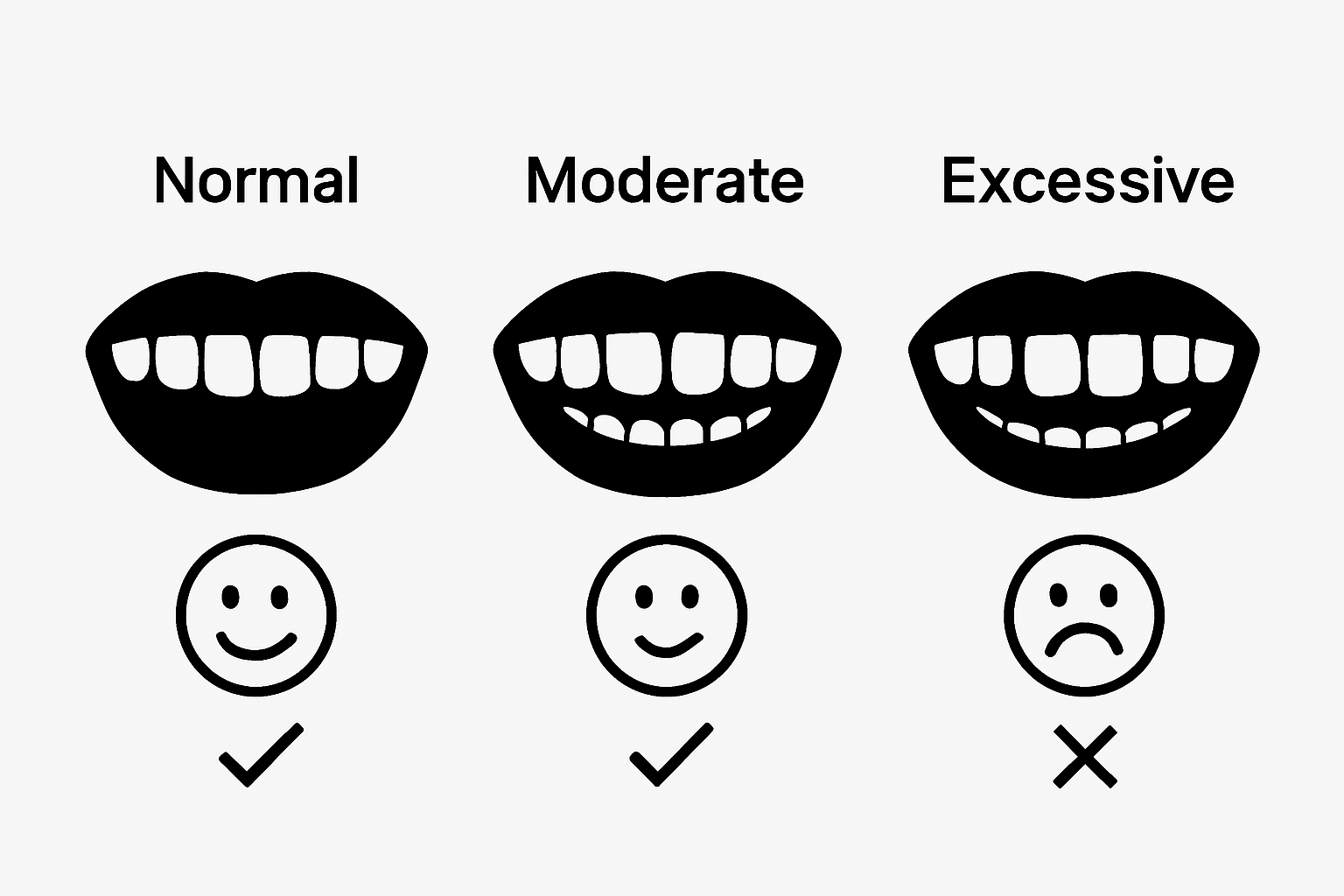Understanding Spacing Between Teeth: Why It Matters
September 23, 2025
Understanding Spacing Between Teeth: Why It Matters
Spacing between teeth might sound like just a cosmetic issue, but it actually goes much deeper than looks. Around 20 percent of kids and teens develop noticeable spaces or gaps between their teeth. Most people expect these gaps to be a minor flaw, yet they can cause bigger problems like speech issues, tough-to-clean teeth, and even impact your confidence. That unexpected link between your smile and your overall oral health is probably more important than you think.
Table of Contents
- What Is Spacing Between Teeth And Why Does It Matter?
- The Impact Of Spacing On Oral Health And Functionality
- How Spacing Between Teeth Affects Aesthetics And Confidence
- Understanding Orthodontic Solutions For Spacing Issues
- The Role Of Age And Growth In Managing Spacing Concerns
Quick Summary
| Takeaway | Explanation |
|---|---|
| Dental spacing affects oral health. | Gaps between teeth can lead to hygiene issues and increase the risk of periodontal disease if not addressed. |
| Professional evaluation is crucial. | Determining whether dental spacing is natural or requires treatment needs an orthodontic assessment by a specialist. |
| Psychological effects of dental spacing exist. | Dental aesthetics influence self-esteem, social interactions, and confidence, impacting emotional well-being. |
| Age influences dental spacing patterns. | Spacing varies between childhood and adulthood due to developmental changes, making age-specific assessment important. |
| Orthodontic treatments can improve spacing. | Several effective methods, such as braces or aligners, are available to correct spacing and enhance dental alignment. |
What is Spacing Between Teeth and Why Does It Matter?
Spacing between teeth, medically known as diastema, refers to the visible gaps or spaces that naturally occur between teeth. These spaces can develop in various locations within the dental arch and range from subtle to quite pronounced.
The table below summarizes key factors that influence the development of dental spacing, providing a side-by-side view of how each factor contributes to gaps between teeth.
| Factor | Description |
|---|---|
| Genetic Predisposition | Inherited characteristics like tooth and jaw size affecting spacing |
| Tooth Size vs. Jaw Size | Discrepancies between the size of teeth and the jaw can create extra space |
| Soft Tissue Attachments | Abnormal gum or tissue connections can cause or worsen gaps |
| Muscular Imbalances | Muscle patterns affecting the positioning of teeth |
| Early Tooth Loss | Loss of baby or permanent teeth early in life can create more space |
| While some individuals view dental spacing as a cosmetic concern, it actually represents a complex interplay of genetic, developmental, and functional factors that impact overall oral health. |
Understanding Dental Spacing Mechanisms
Teeth spacing happens through multiple biological mechanisms. Genetic predisposition plays a significant role, with some individuals inheriting characteristics that promote wider interdental spaces. Factors like tooth size, jaw structure, and soft tissue attachments can contribute to natural spacing patterns. Additionally, developmental processes during childhood and adolescence influence how teeth align and emerge.
Research from the National Institutes of Health indicates that dental spacing can result from several key factors:
- Discrepancies between tooth and jaw size
- Abnormal soft tissue attachments
- Muscular imbalances affecting dental positioning
- Early tooth loss creating unexpected gaps
Implications of Dental Spacing
Beyond aesthetic considerations, spacing between teeth carries important functional and health implications. Moderate spacing can actually provide beneficial airflow and easier cleaning between teeth. However, excessive or uneven spacing might indicate underlying orthodontic issues requiring professional assessment.
Significant dental spacing can potentially:

- Increase vulnerability to periodontal disease
- Create challenges in maintaining optimal oral hygiene
- Impact speech articulation
- Contribute to potential jaw alignment problems
Professional evaluation becomes crucial in understanding whether dental spacing represents a natural variation or signals a condition requiring intervention. Orthodontic specialists can conduct comprehensive assessments to determine the most appropriate approach for individual dental spacing scenarios.
The Impact of Spacing on Oral Health and Functionality
Dental spacing is not merely a cosmetic consideration but a critical factor in overall oral health and functionality.
The spaces between teeth can significantly influence how individuals eat, speak, and maintain oral hygiene. Understanding these complex interactions helps patients and dental professionals develop comprehensive strategies for optimal dental wellness.
Oral Hygiene and Bacterial Accumulation
Spacing between teeth creates unique challenges for maintaining proper oral hygiene. Wider gaps can become potential traps for food particles and bacterial colonies, increasing the risk of plaque formation and subsequent dental problems. Research from the National Institutes of Health demonstrates that diastema can serve as critical sites for potential oral health complications.
Key challenges in oral hygiene related to dental spacing include:
- Increased difficulty in thorough brushing and flossing
- Higher risk of bacterial colonization in interdental spaces
- Potential for accelerated tartar buildup
- Compromised effectiveness of standard cleaning techniques
Functional Implications of Dental Spacing
Beyond hygiene concerns, dental spacing can substantially impact oral functionality. The arrangement of teeth influences critical functions like chewing, speaking, and bite distribution. Significant spacing might alter how bite forces are transmitted through the jaw, potentially leading to more complex dental and muscular challenges.
Potential functional impacts of dental spacing encompass:
- Altered mastication (chewing) mechanics
- Potential speech articulation difficulties
- Uneven distribution of bite pressure
- Increased strain on surrounding oral muscles
Professional orthodontic assessment becomes crucial in understanding these nuanced interactions and developing targeted interventions that address both aesthetic and functional considerations of dental spacing.
How Spacing Between Teeth Affects Aesthetics and Confidence
Dental aesthetics play a pivotal role in personal perception and social interactions. Spacing between teeth extends far beyond physical appearance, profoundly influencing an individual’s psychological and emotional well-being. Understanding these intricate connections helps contextualize how seemingly minor dental variations can significantly impact personal confidence and social experiences.
Psychological Impact of Dental Appearance
The visual presentation of teeth represents a critical component of facial aesthetics and personal image. Uneven or pronounced spacing can trigger complex emotional responses, potentially affecting social interactions and self-perception. Research from the Journal of Orthodontic Science reveals that dental irregularities frequently correlate with psychological challenges related to self-esteem and social confidence.
Psychological dimensions of dental spacing include:
- Increased self-consciousness during social interactions
- Potential avoidance of smiling or laughing openly
- Heightened sensitivity to perceived judgment
- Reduced willingness to engage in public speaking
Cultural and Social Perceptions of Dental Aesthetics
Social standards and cultural expectations significantly influence how dental spacing is perceived. While some cultures embrace unique dental characteristics, others maintain more rigid aesthetic standards. These perceptions can create substantial psychological pressure, particularly among younger individuals navigating complex social environments.

Factors influencing social perceptions of dental spacing encompass:
- Media representations of ideal dental aesthetics
- Professional and personal interaction dynamics
- Cultural beauty standards
- Individual personal experiences and background
Professional orthodontic interventions offer comprehensive solutions that address both functional and aesthetic concerns, empowering individuals to achieve improved dental alignment and enhanced personal confidence.
Understanding Orthodontic Solutions for Spacing Issues
Orthodontic treatments offer sophisticated approaches to addressing dental spacing challenges. These advanced interventions go beyond cosmetic improvements, targeting functional and structural dental alignment to enhance overall oral health and patient confidence. Modern orthodontic solutions provide personalized strategies that consider individual dental anatomy and specific spacing characteristics.
Comprehensive Diagnostic Assessment
Effective orthodontic treatment begins with a thorough diagnostic process. Orthodontists utilize advanced imaging technologies to create detailed three-dimensional mappings of dental structures. This comprehensive evaluation allows for precise identification of spacing issues, enabling targeted and customized treatment approaches.
Key diagnostic considerations include:
- Detailed dental and skeletal structural analysis
- Comprehensive evaluation of bite mechanics
- Assessment of soft tissue interactions
- Identification of potential underlying developmental factors
Treatment Modalities for Dental Spacing
Research from the American Journal of Orthodontics highlights multiple sophisticated strategies for addressing dental spacing. Contemporary orthodontic solutions range from minimally invasive techniques to more comprehensive structural interventions. These approaches are carefully selected based on individual patient requirements, considering factors like age, dental complexity, and desired outcomes.
Primary orthodontic strategies for managing spacing include:
- Clear aligner therapies
- Traditional braces
- Dental bonding procedures
- Targeted enamel reduction techniques
- Surgical orthodontic interventions for complex cases
Professional orthodontic treatments not only address immediate spacing concerns but also establish foundational dental alignment that supports long-term oral health and functional integrity. Each intervention is meticulously designed to provide optimal aesthetic and functional outcomes tailored to individual patient needs.
The Role of Age and Growth in Managing Spacing Concerns
Dental spacing is a dynamic process intricately linked with human growth and developmental stages. Each phase of dental development presents unique characteristics that significantly influence tooth positioning, alignment, and potential spacing variations. Understanding these biological progression patterns helps dental professionals design more effective and personalized treatment strategies.
Developmental Stages and Dental Spacing
Research from pediatric dental studies reveals that dental spacing undergoes complex transformations throughout different life stages. From early childhood through adolescence, multiple factors contribute to changes in tooth positioning and interdental spaces. These developmental shifts are not random but follow predictable biological mechanisms related to jaw growth, tooth eruption, and soft tissue interactions.
Key developmental factors influencing dental spacing include:
- Variations in jaw bone growth rates
- Sequential tooth eruption patterns
- Changes in muscular and soft tissue attachments
- Genetic predispositions toward dental arch development
Age-Related Spacing Characteristics
Each age group presents distinct dental spacing challenges and opportunities. Pediatric dental stages involve natural spacing phenomena that differ significantly from adult dental configurations. Early childhood typically demonstrates more pronounced spacing, which gradually transforms as permanent teeth emerge and jaw structures mature.
Important age-related spacing considerations encompass:
- Preschool and early childhood spacing patterns
- Transitional spacing during permanent tooth emergence
- Adolescent dental arch consolidation
- Adult dental stability and potential spacing shifts
Professional orthodontic assessments consider these nuanced developmental stages, enabling tailored interventions that support optimal dental alignment and functionality throughout an individual’s growth trajectory.
The following table compares dental spacing characteristics and concerns throughout key life stages, helping to visualize how age impacts spacing patterns and treatment needs.
| Age Group | Spacing Characteristics | Common Concerns or Focus |
|---|---|---|
| Preschool Children | Natural, often pronounced spacing | Normal part of development |
| School-age Children | Transitional gaps as baby teeth fall out | Monitoring for abnormal spacing |
| Adolescents | Spacing reduces as permanent teeth emerge | Assessing need for orthodontic review |
| Adults | Stable alignment or potential late-in-life gaps | Long-term health and aesthetics |
Close the Gap on Dental Spacing with Glow Orthodontics
Are you frustrated by the spaces between your teeth impacting both your confidence and oral health? The article highlights how dental spacing, known as diastema, can affect everything from easy cleaning and speech to how you feel about your smile. At Glow Orthodontics, we understand that managing these gaps goes beyond appearances. You want a solution that boosts not only aesthetics but also supports healthier teeth and long-term comfort.

Unlock your best smile today by exploring personalized orthodontic options designed just for you. Visit our welcoming home page to get started—our expert team offers solutions ranging from Invisalign to advanced braces, tailored for both adults and kids. If you are ready to address dental spacing for good, book your consultation at Glow Orthodontics now. Take the first step toward newfound confidence and improved oral health. Spots fill quickly, so acting today means you get closer to a glowing, gap-free smile sooner.
Frequently Asked Questions
What causes spacing between teeth?
Dental spacing, or diastema, can be caused by various factors such as genetic predisposition, discrepancies between tooth and jaw size, abnormal soft tissue attachments, and early tooth loss.
How does spacing between teeth affect oral health?
Spacing can influence oral health by making it easier for food particles to accumulate, potentially leading to plaque formation. Significant spacing may also increase the risk of periodontal disease and could complicate oral hygiene practices.
What are the aesthetic impacts of spacing between teeth?
Spacing can affect personal confidence and social interactions, as individuals may feel self-conscious about their appearance. Perceptions of dental aesthetics can vary across cultures, influencing how spacing is viewed socially.
What orthodontic treatments are available for dental spacing?
Orthodontic treatments for spacing issues include clear aligner therapies, traditional braces, dental bonding procedures, and in some cases, surgical interventions. A professional evaluation can determine the best approach for each individual.